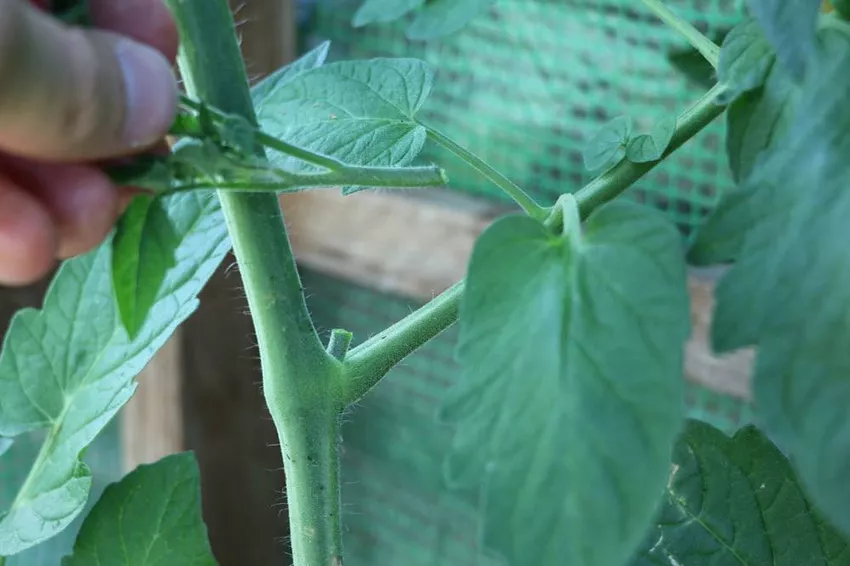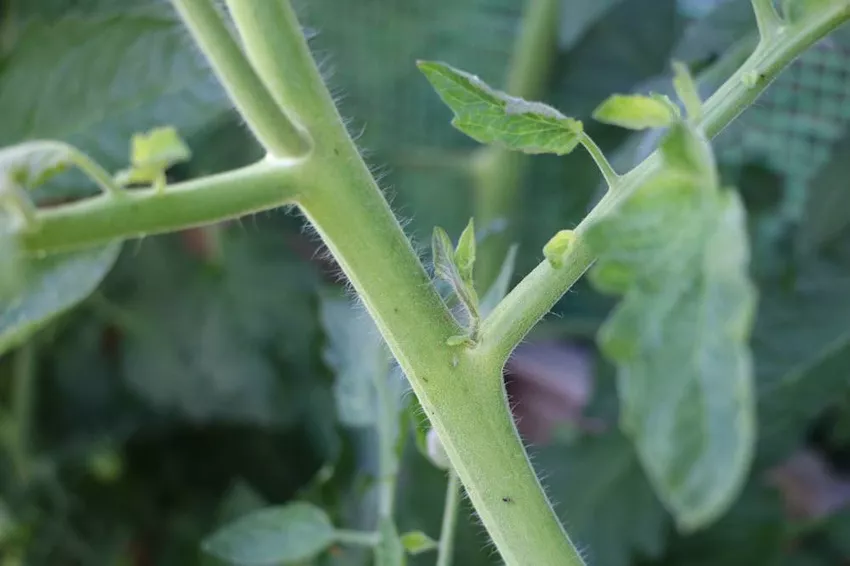
Tomatoes are one of the most popular fruits in the garden. In order for the wonderfully red fruits to grow to a considerable size, it not only requires good care of the location, soil and irrigation. Above all, it is also important to pinch out the middle shoots, which would like to develop between the actual shoots. Here it is important to ensure that the correct shoots are removed.
maintenance
The distinction of tomatoes determines their care
In general, tomatoes are divided into their growth type, size, color of the fruit and taste.
Tomatoes by type of growth
- Stick tomatoes, bush tomatoes, hanging tomatoes
size of the fruit
- Fruit tomatoes, cherry tomatoes, currant tomatoes
color of the fruit
- White, yellow and orange to dark orange, pink, red, purple, brown, green and black
- Variations: Tomatoes also have a pattern and appear striped, mackerel, marbled and spotted
taste of the fruit
- sour, sweet, fruity, vinous and spicy

General
The correct cultivation of tomatoes occupies every hobby gardener. Each variety responds to the peculiarities of soil and climate. It is all the more interesting to watch the tomatoes grow and to know when and where the unwanted shoots are pinched out. We describe here in detailed instructions how to cultivate the tomatoes and how to use them properly. We take a look at the different growth forms and give helpful tips for cultivating tomatoes.
The tomato is the most widespread cultivated plant worldwide. Thousands of varieties have been bred over the centuries. In addition, modern breeding has produced numerous F1 hybrids in particular. In southern countries, the seeds can go directly into the field, in Germany they are preferred in the early culture and then planted out in May.
If you want to protect tomato plants from possible frequent rain showers, you can grow your tomatoes in a special tomato house. Here the plants get enough sun and are protected from high humidity.
sorts
With over 3000 tomato varieties, we would like to introduce some of the so-called old varieties. They differ mainly in that they are not bred as F1 hybrids and are therefore usually very robust and resilient. Old tomato varieties are also much more convincing in terms of taste. Most varieties are pinched to ensure a bountiful harvest.
Lettuce Tomato Paul Robson (Solanum lycopersicum)
- which is dark in color and has a soft flesh
- very pleasant in taste, has a slightly sweet aroma
- ideal for making tomato paste
Market tomato San Marzano (Solanum lycopersicum)
- one of the most popular tomatoes for pizza and toppings
- firm flesh without much liquid
- is therefore ideal as a topping or for drying tomatoes
Wild tomato currant (currant tomato)
- grows only about one centimeter
- very tasty, aromatic fruits
- Tomatoes growing in long clusters turn yellow to bright orange-yellow
- very good for the bucket

Conventional tomato varieties
Tomato Moneymaker (Lycopersicon esculentum)
- an early variety that produces medium-sized fruit
- small tomatoes, which are very good for snacking or in a salad
Plum Tomato Roma (Lycopersicon esculentum)
- a medium tall and medium to late ripening tomato
- with egg-shaped fruits and firm flesh
Historical tomato varieties
De Berao
- originally from Irkutsk Russia today has many fans in Europe
- very aromatic, firm and easy to store
- suitable for outdoor cultivation
- hardly susceptible to diseases
- can grow very tall and reach a height of up to three meters
Corne de Bouc
- which develops pointed, squirrel-like fruits
- a red specialty with a pleasantly sweet and full aroma
- belongs to the old French landraces and prefers a rain canopy

Variety rarity
Banana Legs
- a yellow bush tomato with large, elongated fruits
A good and bountiful harvest can be expected from tomatoes if they grow with one or two shoots. For this reason, the superfluous shoots must be removed during the growth phase. If there are too many leaves and shoots, the tomatoes themselves will not get enough energy and will not develop optimally. So it is important to keep checking and removing newly emerging shoots.
max out
The answer to the question: why exhaust tomatoes?
Here, the natural growth of the tomato plant must be observed. A tomato plant naturally likes to grow in width and form many branched side shoots. But the result is on the one hand a lack of space for the fruit hanging, on the other hand all the energy goes into the many leaves and shoots instead of into the fruit itself. As a result, relatively small tomatoes grow. For this reason, the side shoots are removed from the plant and the power of the nutrients is directed into large tomatoes.
When removing the stinging shoots, the water and energy balance of the tomato plants should be regulated. It is important that the hobby gardener keeps checking on his plants, because once stinging shoots have been removed, the plant will continue to develop unwanted side shoots. Under optimal weather conditions, new shoots can have developed again after just two days.

Tip: Check tomato plants for new shoots at least once a week.
What?
Which shoots need to be removed?
Anyone who has not yet had any experience of cutting out tomatoes must be able to distinguish between the actual fruit drive and the miserly drive.
The following applies:
- the fruit shoot grows directly out of the strong main shoot
- the stinging instinct, on the other hand, develops in the branching of the main stem and an already existing petiole
So the difference between these two drives is clearly visible. When the stinging instinct has reached a length of about three centimetres, it is clipped off with your fingers. The still very soft shoot is grabbed and snapped off directly in the branching. Do not use a knife or scissors here, as there is a high risk of damaging other shoots. If you have overlooked some stinging shoots, they will grow up quickly. Take them off anyway.

Remember that tomato plants have an intense scent. One hobby gardener loves the fresh tomato aroma, the other doesn't. If you don't like it, you should wear thin gloves - preferably disposable gloves - to protect yourself from the plant juices. However, they are not dangerous.
When?
When to eat tomatoes?
Also important: the time when stinging shoots are removed.
It is advisable to cut off the stinginess in the morning. The heat from the sun can dry the fracture faster during the day than at night. For the same reason, you should avoid removing the stinging shoots when it rains. It is also important to ensure cleanliness, because even a tomato plant can be damaged by improper handling. Many gardeners fear infections that, once broken out, can also be transmitted to nearby plants. It is therefore actually a good idea to wear disposable gloves when removing the stinging shoots.

exception
Exception when exhausting
bush tomatoes
The bush tomato is heavily branched and, at best, grows like a beautiful, bushy shrub. The more branched, the more shoots it forms - and it is precisely these that must not be pinched! The delicious fruits often grow here. The bush tomatoes, which grow like bushes, not only thrive in the vegetable patch, but also in the tub on the balcony or terrace.
Instead, they are supported in their growth and receive a climbing aid or support to prevent the shoots with their numerous fruits from sinking to the ground. The tomato stick, which is made of galvanized steel, or shorter splitting sticks, which are particularly suitable for tomato varieties up to a height of 40 centimeters, are suitable for this.
Even a simple bamboo cane, which can be cut to the desired length, is a good climbing aid. With all types of bush tomatoes, be prepared for vigorous plants from which you can soon harvest many tomatoes for salads.

In addition to bush tomatoes, cocktail tomatoes, vine tomatoes and wild tomatoes are not exhausted. They are similar in growth and fruit development. In addition, no larger tomatoes form here, since these are small-growing tomato varieties anyway.
Can I save myself the hassle?
In the best case yes! Because if you have more than 20 tomato plants in the garden, you will have to invest a lot of time just with the stinging. The preparatory work begins with sowing. This may sound confusing at first glance, but it becomes clearer when you think twice about it. The right time for the young plants is important. If these are planted too early or placed in an unfavorable location, they will develop many small side shoots due to the lack of light.
The young plants should therefore definitely stand on a warm windowsill or greenhouse. The earliest time for pre-cultivation is the end of February - before that, the seedlings and young plants simply lack light, which is another reason for the development of side shoots. They do not come outdoors until the end of March or the end of May, depending on regional weather conditions.
Caution! This is how you prevent side shoots
If tomato plants are grown in too little light, they form many shoots and especially side shoots, which later cause a lot of work.

Strong main shoots with a few side shoots only develop under favorable growing conditions - warm and bright.
tip
Use young stinging shoots as fresh cuttings
Once the young stinging shoots have reached a suitable size, they can even be used as cuttings. There is enormous growth power in the tiny shoots, so that a new plant can be grown directly here. Immediately after clipping, use a mixture of fresh garden soil, a third of sand and a little compost.
Two-thirds of the cutting is planted in the ground and watered; a plastic bag over the young plant is beneficial. This promotes rooting. At around 20 °C, rooting progresses quickly. After about two weeks, the young cuttings can be repotted in a plant pot or the vegetable patch.